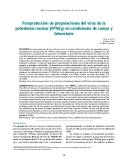| dc.description.abstract | En una plantación de soya (Glycine max) se evaluó el efecto de la hora de aplicación sobre la persistencia de preparaciones de VPNAg, comparando la fotoprotección conferida al patógeno por dos formulaciones. Las aplicaciones se realizaron a las 08:00h y a las 12:00h. Una hora después, así como a los tres y seis días después de la aplicación del virus se recolectaron folíolos de cada una de las parcelas tratadas y con ellos se alimentaron larvas de Anticarsia gemmatalis, mantenidas en laboratorio. Bajo las condiciones ambientales prevalecientes durante el experimento no hubo relación entre la actividad patogénica de los productos evaluados y la hora de aplicación. La persistencia fue mayor con la formulación del patógeno con respecto al patógeno sin formular. La formulación en aceite emulsionable logró mayor persistencia que la formulación en polvo mojable, determinándose para el aceite emulsionable la mayor reducción en la actividad del patógeno entre los tres y seis días, solamente cuando la aplicación se realizó en el período de mayor incidencia de radiación ultravioleta (12:00h). Para la formulación de polvo mojable la reducción de la actividad ocurrió al tercer día después de la aplicación realizada a las 8:00h, a pesar de tener una menor UV, reduciéndose más para el sexto día. Este resultado coincide con lo observado para esta formulación aplicada a las 12:00h. The effect of the hour of application on the persistence of VPNAg preparations was evaluated on a soybean (Glycine max) plantation, comparing the photoprotection conferred by two formulations on the pathogen. The applications were performed at 8:00h and at 12:00h. After one hour, and also three and six days after application of the virus, leaves were collected from each of the treated plots and used as food for Anticarsia gemmatalis larvae, maintained in the laboratory. There was no relation between the pathogenic activity of the evaluated products and the hour of application under the prevalent ambient conditions of the experiment. The persistence of the formulated pathogen was greater than the pathogen without formulation. The formulation in oil emulsion achieved greater persistence than the formulation in wetable powder, the greatest reduction in pathogen activity for the oil emulsion was determined between three and six days, only when the application was performed in the period of highest incidence of ultraviolet radiation (12:00h). For the wetable powder formulation the reduction in activity occurred on the third day after the application performed at 8:00h, despite less UV, and was further reduced on the sixth day. This result coincides with the observations of this formulation applied at 12:00h. | es_ES |


